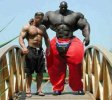This was ripped off a study by Dr. Tudor Bompa. It does not include all the exercises I would have liked to have seen but is a good general guide:
CHEST
Pectoralis Major
Decline dumbell bench press: 93
Decline bench press (olympic): 89
Push-ups between benches: 88
Flat dumbell bench press: 87
Flat bench press: 85
Flat dumbell flys: 84
Pectoralis Minor
Incline dumbell bench press: 91
Incline bench press (olympic): 85
Incline dumbell flys 83:
Incline bench press (Smith): 81
SHOULDERS
Medial Deltoids
Incline dumbell side laterals: 66
Standing dumbell side laterals: 63
Seated dumbell side laterals: 62
Cable side laterals: 47
Posterior Deltoids
Standing dumbell bent laterals: 85
Seated dumbell side laterals: 83
Standing cable bent laterals: 77
Anterior Deltoids
Seated Front Dumbell Press: 79
Standing Front Dumbell Raises: 73
Seated Front Barbell Press: 61
BACK
Latissimus Dorsi
Bent over barbell rows: 93
One arm dumbell rows: 91
T-bar rows: 89
Lat pulldowns (front): 86
Seated pulley rows: 83
BICEPS
Biceps Brachii (long head)
Biceps Preacher Curls (olympic bar): 90
Incline Seated Dumbell Curls (alternate): 88
Standing Biceps Curl (olympic bar/narrow grip): 86
Standing Dumbell Curls (alternate): 84
Concentration Dumbell Curls: 80
Standing Biceps Curls (olympic bar/wide grip): 63
Standing E-Z Biceps Curls (wide grip): 61
TRICEPS
Triceps Brachii (outer head)
Decline Triceps Extensions (olympic bar): 92
Triceps Pressdowns (angled bar): 90
Triceps Dip Between Benches 87:
One-Arm Cable Triceps Extensions (reverse grip): 85
Overhead Rope Triceps Extensions: 84
Seated One-Arm Dumbell Triceps Extensions (neutral grip): 82
Close-Grip Bench Press (olympic bar): 72
LEGS
Rectus Femoris (quadricep)
Safety Squats (90-degree angle, shoulder-width stance): 88
Seated Leg Extensions (toes straight): 86
Hack Squats (90-degree angle, shoulder-width stance): 78
Leg Press (110-degree angle): 76
Smith Machine Squats (90-degree angle, shoulder-width stance): 60
Biceps Femoris (hamstring)
Standing Leg Curls: 82
Lying Leg Curls: 71
Seated Leg Curls: 58
Modified Hamstring Deadlift: 56
Semitendinosus (rear thigh)
Seated Leg Curls: 88
Standing Leg Curls: 79
Lying Leg Curls: 70
Modified hamstring Deadlift: 63
Gastrocnemius (calf)
Donkey Calf Raises: 80
Standing Single-leg Calf Raises: 79
Standing Calf Raises: 68
Seated Calf Raises: 61
CHEST
Pectoralis Major
Decline dumbell bench press: 93
Decline bench press (olympic): 89
Push-ups between benches: 88
Flat dumbell bench press: 87
Flat bench press: 85
Flat dumbell flys: 84
Pectoralis Minor
Incline dumbell bench press: 91
Incline bench press (olympic): 85
Incline dumbell flys 83:
Incline bench press (Smith): 81
SHOULDERS
Medial Deltoids
Incline dumbell side laterals: 66
Standing dumbell side laterals: 63
Seated dumbell side laterals: 62
Cable side laterals: 47
Posterior Deltoids
Standing dumbell bent laterals: 85
Seated dumbell side laterals: 83
Standing cable bent laterals: 77
Anterior Deltoids
Seated Front Dumbell Press: 79
Standing Front Dumbell Raises: 73
Seated Front Barbell Press: 61
BACK
Latissimus Dorsi
Bent over barbell rows: 93
One arm dumbell rows: 91
T-bar rows: 89
Lat pulldowns (front): 86
Seated pulley rows: 83
BICEPS
Biceps Brachii (long head)
Biceps Preacher Curls (olympic bar): 90
Incline Seated Dumbell Curls (alternate): 88
Standing Biceps Curl (olympic bar/narrow grip): 86
Standing Dumbell Curls (alternate): 84
Concentration Dumbell Curls: 80
Standing Biceps Curls (olympic bar/wide grip): 63
Standing E-Z Biceps Curls (wide grip): 61
TRICEPS
Triceps Brachii (outer head)
Decline Triceps Extensions (olympic bar): 92
Triceps Pressdowns (angled bar): 90
Triceps Dip Between Benches 87:
One-Arm Cable Triceps Extensions (reverse grip): 85
Overhead Rope Triceps Extensions: 84
Seated One-Arm Dumbell Triceps Extensions (neutral grip): 82
Close-Grip Bench Press (olympic bar): 72
LEGS
Rectus Femoris (quadricep)
Safety Squats (90-degree angle, shoulder-width stance): 88
Seated Leg Extensions (toes straight): 86
Hack Squats (90-degree angle, shoulder-width stance): 78
Leg Press (110-degree angle): 76
Smith Machine Squats (90-degree angle, shoulder-width stance): 60
Biceps Femoris (hamstring)
Standing Leg Curls: 82
Lying Leg Curls: 71
Seated Leg Curls: 58
Modified Hamstring Deadlift: 56
Semitendinosus (rear thigh)
Seated Leg Curls: 88
Standing Leg Curls: 79
Lying Leg Curls: 70
Modified hamstring Deadlift: 63
Gastrocnemius (calf)
Donkey Calf Raises: 80
Standing Single-leg Calf Raises: 79
Standing Calf Raises: 68
Seated Calf Raises: 61

